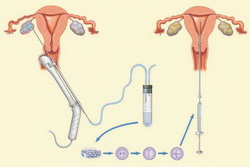After trying different fertility methods and nothing works, then treatment IVF could be the ultimate solution to have your own baby.

Treatment IVF has been growing in popularity because it effectively resolves the issues affecting infertile couples. Oftentimes, in vitro fertilization treatment is undertaken if other conventional fertility methods have failed to help couples conceive a baby. Besides, it is also used in females with damaged fallopian tubes as well as severe infertility cases among males.
The treatment procedure involves harvesting the eggs from the female's ovary and combining them with male's sperm cells allowing them to fertilize in a laboratory dish. Once these fertilized eggs have grown into 8-cell embryos, they will be transferred back into the uterus. Treatment IVF is the final resort for couples suffering from severe infertility.
Let us take a comprehensive overview about this form of fertility method.
History of Treatment IVF
This certain form of fertility method dates back to 1978 when success rates were fairly low. But with further research and advancement in medical technologies, success rates eventually grew resulting to the emergence of the first ever test tube baby in England. In 1985, the success rate was only 5 percent and climbed to 30 percent in 2006.
IVF Treatment Procedure
The fundamental stage in treatment IVF is inducing ovulation to stimulate the female ovary to produce more eggs. The ripened eggs are then taken from the woman's body through an aspirating needle and combined with the sperm cells in a laboratory dish. The sperms then fertilize the ripened eggs forming embryos. They are incubated up to five days to stir growth. After which, the most healthy embryos are preferred and transferred back into the woman's uterus through catheter insertion on the cervix. Implantation will then take place resulting to the manifestations of pregnancy symptoms.
Time Frame of Treatment IVF
Every phase of treatment IVF takes up to four weeks commencing from induction of ovulation to transferring of fertilized embryos. After two weeks, couple will then find out if the treatment resulted to pregnancy. In case it fails to end in pregnancy, natural menstrual cycle is allowed before starting the procedure once again. Most couples were able to conceive after three rounds of treatment IVF.
Pros and Cons of Treatment IVF
Treatment IVF makes it possible for barren couples to conceive. Regardless of any situation, the fertilized eggs will always join with the sperm cells and are inserted back into the uterus for implantation. On the other hand, you need to be patient because the treatment seldom results in pregnancy during the first round of procedure. You need to handle your frustration well when you learn that the treatment failed.
Mistaken Belief of Treatment IVF
Oftentimes, children born with the aid of treatment IVF are thought of as test tube babies. Granted, the embryos are developed in laboratory dish, but the implantation and growth take place inside the mother's womb. Also, many think that the procedure is very easy. On the contrary, it is a very difficult process which requires several moths of careful planning and close monitoring to guarantee that the retrieval of mature eggs and embryo transfer occur at appropriate times.
